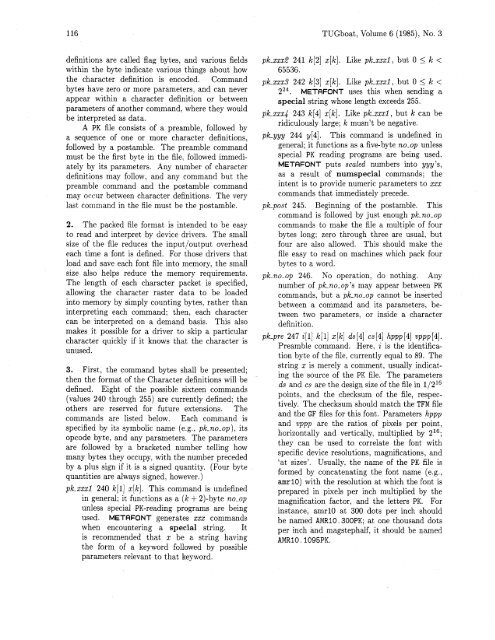(PK) font file format - TUG
(PK) font file format - TUG
(PK) font file format - TUG
Create successful ePaper yourself
Turn your PDF publications into a flip-book with our unique Google optimized e-Paper software.
116 <strong>TUG</strong>boat, Volume 6 (1985), No. 3<br />
definitions are called flag bytes, and various fields<br />
within the byte indicate various things about how<br />
the character definition is encoded. Command<br />
bytes have zero or more parameters, and can never<br />
appear within a character definition or between<br />
parameters of another command, where they would<br />
be interpreted as data.<br />
A <strong>PK</strong> <strong>file</strong> consists of a preamble, followed by<br />
a sequence of one or more character definitions,<br />
followed by a postamble. The preamble command<br />
must be the first byte in the <strong>file</strong>, followed immediately<br />
by its parameters. Any number of character<br />
definitions may follow, and any command but the<br />
preamble command and the postamble command<br />
may occur between character definitions. The very<br />
last command in the <strong>file</strong> must be the postamble.<br />
2. The packed <strong>file</strong> <strong>format</strong> is intended to be easy<br />
to read and interpret by device drivers. The small<br />
size of the <strong>file</strong> reduces the input/output overhead<br />
each time a <strong>font</strong> is defined. For those drivers that<br />
load and save each <strong>font</strong> <strong>file</strong> into memory, the small<br />
size also helps reduce the memory requirements.<br />
The length of each character packet is specified,<br />
allowing the character raster data to be loaded<br />
into memory by simply counting bytes, rather than<br />
interpreting each command; then, each character<br />
can be interpreted on a demand basis. This also<br />
makes it possible for a driver to skip a particular<br />
character quickly if it knows that the character is<br />
unused.<br />
3. First, the command bytes shall be presented;<br />
then the <strong>format</strong> of the Character definitions will be<br />
defined. Eight of the possible sixteen commands<br />
(values 240 through 255) are currently defined; the<br />
others are reserved for future extensions. The<br />
commands are listed below. Each command is<br />
specified by its symbolic name (e.g., pk-no-op), its<br />
opcode byte, and any parameters. The parameters<br />
are followed by a bracketed number telling how<br />
many bytes they occupy, with the number preceded<br />
by a plus sign if it is a signed quantity. (Four byte<br />
quantities are always signed, however.)<br />
pk-xxxl 240 k[l] x[k]. This command is undefined<br />
in general; it functions as a (k + 2)-byte no-op<br />
unless special <strong>PK</strong>-reading programs are being<br />
used. METAFONT generates xxx commands<br />
when encountering a special string. It<br />
is recommended that x be a string having<br />
the form of a keyword followed by possible<br />
parameters relevant to that keyword.<br />
pk-xxx2 241 k[2] x[k]. Like pk-xxxl, but 0 I k <<br />
65536.<br />
pk-xxx3 242 k[3] x[k]. Like pk-xxxl, but 0 5 k <<br />
224. METAFONT uses this when sending a<br />
special string whose length exceeds 255.<br />
pk-xxx4 243 3141 x[k]. Like pk-xxxl, but k can be<br />
ridiculously large; k musn't be negative.<br />
pk-yyy 244 y[4]. This command is undefined in<br />
general; it functions as a five-byte no-op unless<br />
special <strong>PK</strong> reading programs are being used.<br />
METAFONT puts scaled numbers into yyy's,<br />
as a result of numspecial commands; the<br />
intent is to provide numeric parameters to xxx<br />
commands that immediately precede.<br />
pk-post 245. Beginning of the postamble. This<br />
command is followed by just enough pk-no-op<br />
commands to make the <strong>file</strong> a multiple of four<br />
bytes long; zero through three are usual, but<br />
four are also allowed. This should make the<br />
<strong>file</strong> easy to read on machines which pack four<br />
bytes to a word.<br />
pk-no-op 246. No operation, do nothing. Any<br />
number of pk-no-op's may appear between <strong>PK</strong><br />
commands, but a pk-no-op cannot be inserted<br />
between a command and its parameters, between<br />
two parameters, or inside a character<br />
definition.<br />
pk-pre 247 i[l] k[l] x[k] ds [4] cs [4] hppp [4] vppp 141.<br />
Preamble command. Here, i is the identification<br />
byte of the <strong>file</strong>, currently equal to 89. The<br />
string x is merely a comment, usually indicating<br />
the source of the <strong>PK</strong> <strong>file</strong>. The parameters<br />
ds and cs are the design size of the <strong>file</strong> in 1/216<br />
points, and the checksum of the <strong>file</strong>, respectively.<br />
The checksum should match the TFM <strong>file</strong><br />
and the GF <strong>file</strong>s for this <strong>font</strong>. Parameters hppp<br />
and vppp are the ratios of pixels per point,<br />
horizontally and vertically, multiplied by 216;<br />
they can be used to correlate the <strong>font</strong> with<br />
specific device resolutions, magnifications, and<br />
'at sizes'. Usually. the name of the <strong>PK</strong> <strong>file</strong> is<br />
formed by concatenating the <strong>font</strong> name (e.g.,<br />
amrl0) with the resolution at which the <strong>font</strong> is<br />
prepared in pixels per inch multiplied by the<br />
magnification factor, and the letters <strong>PK</strong>. For<br />
instance, amrlO at 300 dots per inch should<br />
be named AMRIO. 300<strong>PK</strong>; at one thousand dots<br />
per inch and magstephalf, it should be named<br />
AMR10.1095<strong>PK</strong>.

















